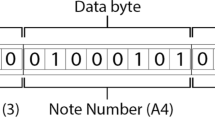Abstract
This paper is a preliminary attempt to investigate the perception of sound movements as expressive gestures. The idea is that if sound movement is used as a musical parameter, a listener (or a subject) should be able to distinguish among different movements and she/he should be able to group them also according to the expressive intention that a given sound movement is supposed to convey. A couple of experiments have been carried out in this direction: first the subjects had to group the stimuli according to the perceived expressive intention, then they had to reproduce the sound movement by drawing it on a tablet. Preliminary results show that subjects could consistently group the stimuli, and that they primarily used paths and legato–staccato patterns to discriminate among different sound movements/expressive intention.
Access this chapter
Tax calculation will be finalised at checkout
Purchases are for personal use only
Similar content being viewed by others
Notes
- 1.
lontano: as from far away.
- 2.
- 3.
References
Andersen, T.H., Zhai, S.: “writing with music”: Exploring the use of auditory feedback in gesture interfaces. ACM Trans. Appl. Percept. 7(3), 17:1–17:24 (2008). http://doi.acm.org/10.1145/1773965.1773968
Bernardini, N., Vidolin, A.: Recording orfeo cantando... tolse by Adriano Guarnieri: sound motion and space parameters on a stereo cd. In: Proceedings of the XII Colloquio di Informatica Musicale - Gorizia 1998, Gorizia, pp. 262–265 (1998)
Bernardini, N., Vidolin, A.: Note di Live Electronics, pp. 157–161. Edizioni del Teatro La Fenice, Venezia (2002)
Bigand, E., Vieillard, S., Madurell, F., Marozeau, J., Dacquet, A.: Multidimensional scaling of emotional responses to music: the effect of musical expertise and of the duration of the excerpts. Cogn. Emot. 19(8), 1113–1139 (2005). http://dx.doi.org/10.1080/02699930500204250
Blauert, J.: Spatial Hearing: The Psychophysics of Human Sound Localization. MIT Press, Cambridge (1983)
Bresin, R., Friberg, A.: Evaluation of computer systems for expressive music performance. In: Kirke, A., Miranda, E.R. (eds.) Guide to Computing for Expressive Music Performance, pp. 181–203. Springer, London (2013). http://dx.doi.org/10.1007/978-1-4471-4123-5_7
Camurri, A., Volpe, G., Poli, G.D., Leman, M.: Communicating expressiveness and affect in multimodal interactive systems. IEEE MultiMedia 12(1), 43–53 (2005). http://dx.doi.org/10.1109/MMUL.2005.2
de Götzen, A.: Enhancing engagement in multimodality environments by sound movements in a virtual space. IEEE MultiMedia 11(2), 4–8 (2004). http://dx.doi.org/10.1109/MMUL.2004.1289034
Imberty, M.: Entendre la musique. Sémantique psychologique de la musique. Dunod (1979)
Juslin, P., Sloboda, J.: Psychological Perspectives on Music and Emotion, Music and Emotion-Theory and Research. Oxford University Press, Oxford (2001)
Kendall, G., Martens, W.: Simulating the cues of spatial hearing in natural environments. In: Proceedings of the International Computer Music Conference 1984, pp. 111–125. International Computer Music Association, San Francisco (1984)
Rocchesso, D., Delle Monache, S.: Perception and replication of planar sonic gestures. ACM Trans. Appl. Percept. 9(4), 18:1–18:21 (2012). http://doi.acm.org/10.1145/2355598.2355601
Stockhausen, K.: Musik in Raum. Dumont-Verlag, Köln (1958)
Thoret, E., Aramaki, M., Kronland-Martinet, R., Velay, J.L., Ystad, S.: From sound to shape: auditory perception of drawing movements. J. Exp. Psychol. Hum. Percept. Perform. (2014). http://www.biomedsearch.com/nih/From-Sound-to-Shape-Auditory/24446717.html
Author information
Authors and Affiliations
Corresponding author
Editor information
Editors and Affiliations
Rights and permissions
Copyright information
© 2014 Springer International Publishing Switzerland
About this paper
Cite this paper
de Götzen, A., Sikström, E., Korsgaard, D., Serafin, S., Grani, F. (2014). The Perception of Sound Movements as Expressive Gestures. In: Aramaki, M., Derrien, O., Kronland-Martinet, R., Ystad, S. (eds) Sound, Music, and Motion. CMMR 2013. Lecture Notes in Computer Science(), vol 8905. Springer, Cham. https://doi.org/10.1007/978-3-319-12976-1_30
Download citation
DOI: https://doi.org/10.1007/978-3-319-12976-1_30
Published:
Publisher Name: Springer, Cham
Print ISBN: 978-3-319-12975-4
Online ISBN: 978-3-319-12976-1
eBook Packages: Computer ScienceComputer Science (R0)




